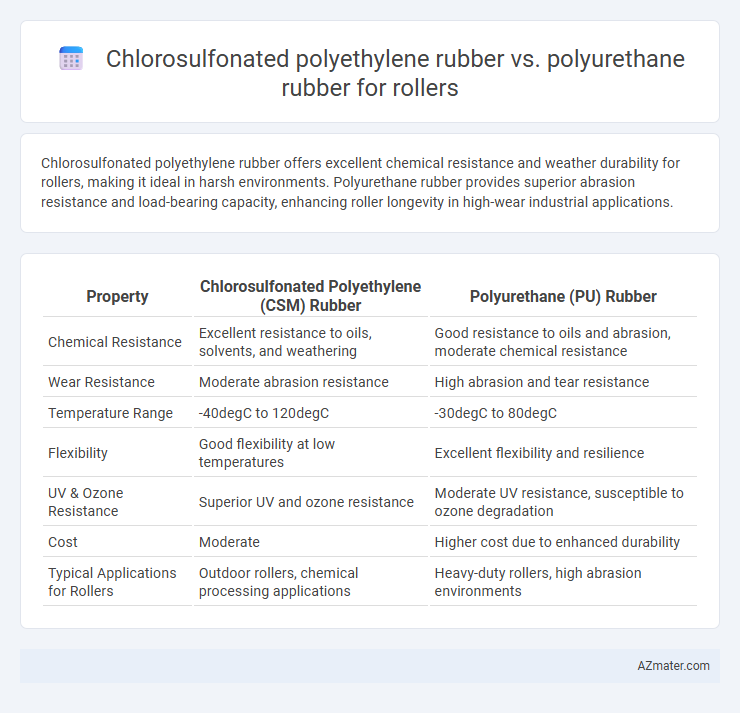Chlorosulfonated polyethylene rubber offers excellent chemical resistance and weather durability for rollers, making it ideal in harsh environments. Polyurethane rubber provides superior abrasion resistance and load-bearing capacity, enhancing roller longevity in high-wear industrial applications.
Table of Comparison
| Property | Chlorosulfonated Polyethylene (CSM) Rubber | Polyurethane (PU) Rubber |
|---|---|---|
| Chemical Resistance | Excellent resistance to oils, solvents, and weathering | Good resistance to oils and abrasion, moderate chemical resistance |
| Wear Resistance | Moderate abrasion resistance | High abrasion and tear resistance |
| Temperature Range | -40degC to 120degC | -30degC to 80degC |
| Flexibility | Good flexibility at low temperatures | Excellent flexibility and resilience |
| UV & Ozone Resistance | Superior UV and ozone resistance | Moderate UV resistance, susceptible to ozone degradation |
| Cost | Moderate | Higher cost due to enhanced durability |
| Typical Applications for Rollers | Outdoor rollers, chemical processing applications | Heavy-duty rollers, high abrasion environments |
Introduction to Roller Materials
Chlorosulfonated polyethylene (CSM) rubber offers exceptional resistance to chemicals, ozone, and weathering, making it suitable for rollers in harsh industrial environments. Polyurethane rubber provides superior abrasion resistance and load-bearing capacity, ideal for rollers subjected to heavy mechanical stress and impact. Selecting the right roller material depends on specific application requirements such as chemical exposure, wear conditions, and load demands.
Overview of Chlorosulfonated Polyethylene Rubber
Chlorosulfonated polyethylene rubber (CSM) offers excellent resistance to chemicals, ozone, UV radiation, and weathering, making it ideal for outdoor roller applications where durability is critical. Its thermooxidative stability and strong adhesion properties enable rollers to maintain flexibility and performance under harsh environmental conditions. Compared to polyurethane rubber, CSM provides superior resistance to hydrocarbons and solvents, enhancing roller lifespan in industrial settings with chemical exposure.
Overview of Polyurethane Rubber
Polyurethane rubber offers exceptional abrasion resistance and high tensile strength, making it ideal for rollers in demanding industrial applications. Its excellent flexibility and resistance to oil, chemicals, and weathering extend the lifespan of rollers compared to chlorosulfonated polyethylene rubber (CSM). Polyurethane's superior load-bearing capacity and dimensional stability enhance roller performance in heavy-duty and high-speed operations.
Mechanical Properties Comparison
Chlorosulfonated polyethylene (CSPE) rubber exhibits excellent resistance to chemicals, weathering, and ozone, making it highly durable for roller applications. Polyurethane rubber offers superior abrasion resistance, higher tensile strength, and better load-bearing capacity compared to CSPE, resulting in longer service life under heavy mechanical stress. While CSPE provides enhanced flexibility and weather resistance, polyurethane's mechanical robustness makes it ideal for rollers subject to intense wear and dynamic forces.
Chemical Resistance Performance
Chlorosulfonated polyethylene (CSM) rubber exhibits superior chemical resistance against oils, fuels, and solvents, making it highly durable in harsh chemical environments compared to polyurethane rubber. Polyurethane rubber offers excellent resistance to abrasion and mechanical stress but generally shows lower tolerance to strong acids, alkalis, and organic solvents. For rollers requiring prolonged exposure to aggressive chemicals, CSM rubber ensures extended service life and reduced degradation.
Abrasion and Wear Resistance
Chlorosulfonated polyethylene (CSM) rubber exhibits superior abrasion resistance and wear durability compared to polyurethane rubber, making it ideal for rollers subjected to harsh industrial environments. CSM's chemical structure provides excellent resistance against weathering, chemicals, and ozone, extending roller lifespan under abrasive conditions. Polyurethane rubber offers good abrasion resistance but generally degrades faster than CSM when exposed to extreme mechanical wear and harsh chemical agents.
Temperature and Environmental Stability
Chlorosulfonated polyethylene (CSM) rubber excels in high temperature resistance, maintaining stability up to 150degC, and offers superior resistance to ozone, UV radiation, and chemicals, making it ideal for harsh environmental conditions. Polyurethane (PU) rubber provides excellent mechanical strength and abrasion resistance but has a lower maximum operating temperature, typically around 80-100degC, limiting its use in elevated temperature applications. For roller applications requiring enhanced thermal stability and environmental resistance, CSM rubber outperforms PU rubber in longevity and durability under aggressive conditions.
Cost and Availability Analysis
Chlorosulfonated polyethylene (CSM) rubber generally offers moderate cost with robust chemical resistance, making it suitable for rollers exposed to harsh environments, though its availability can be limited depending on regional suppliers. Polyurethane rubber typically has a higher initial cost but provides superior abrasion resistance and mechanical properties, resulting in longer roller lifespan and potentially lower total cost of ownership. Availability of polyurethane rollers is widespread globally due to extensive industrial demand, while CSM rollers might require sourcing from specialized manufacturers.
Application Suitability for Rollers
Chlorosulfonated polyethylene (CSM) rubber offers excellent chemical resistance and weatherability, making it ideal for rollers exposed to harsh environments or corrosive substances. Polyurethane rubber provides superior abrasion resistance and load-bearing capacity, suitable for heavy-duty rollers in material handling and industrial conveyor applications. The choice between CSM and polyurethane depends on the specific roller operating conditions, including exposure to chemicals versus mechanical wear.
Conclusion: Selecting the Optimal Rubber for Rollers
Chlorosulfonated polyethylene rubber offers exceptional chemical resistance and weather durability, making it ideal for rollers exposed to harsh environments. Polyurethane rubber provides superior abrasion resistance and load-bearing capacity, suited for high-wear industrial applications. Selecting the optimal rubber depends on specific operational demands, with chlorosulfonated polyethylene preferred for chemical exposure and polyurethane excelling in mechanical wear scenarios.

Infographic: Chlorosulfonated polyethylene rubber vs Polyurethane rubber for Roller
 azmater.com
azmater.com